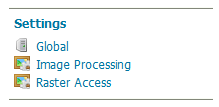Settings
This area contains some configuration parameters that cover general GeoServer behavior. Consider the following screenshot:

Under the Global section, as its name states, you can find very general parameters.
Among those included, it is worth discussing the option to enable Verbose Reporting, shown as follows:

Turning on this flag, you can enable beautification of XML responses in error messages by adding line returns. Enabling this option consumes a lot of resources, so only enable this option if you need to. Verbose exceptions will give you multiline error messages.
It is also important to get confident with the Logging Profile. There are a set of default logging configurations shipped with GeoServer. You can add others in the Log4J configuration format.
You may want to keep your log files outside of the data folder in cases where you want to rotate logs. By default, these are in $GEOSERVER_HOME/data_dir, and you may want to keep this folder clean.
Changing your logging configuration
When...




































































